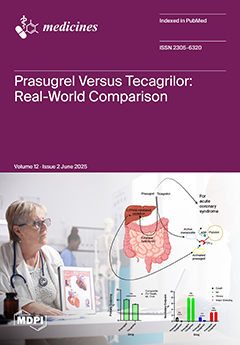Introduction: A direct head-to-head comparison between potent P2Y12 inhibitors: prasugrel versus ticagrelor is still lacking.
Purpose: In this single-center study, we sought to address the efficacy and safety of these two third-generation antiplatelet drugs, after about a decade of practical use.
[...] Read more.
Introduction: A direct head-to-head comparison between potent P2Y12 inhibitors: prasugrel versus ticagrelor is still lacking.
Purpose: In this single-center study, we sought to address the efficacy and safety of these two third-generation antiplatelet drugs, after about a decade of practical use.
Methods: A retrospective observational study included all patients who were admitted with acute coronary syndrome between January 2010 and December 2019 and were discharged with aspirin and either prasugrel or ticagrelor after percutaneous coronary intervention. Patients were divided into two groups based on the dual antiplatelet drugs prescribed. Primary endpoint: A composite endpoint of cardiovascular death, recurrent coronary syndrome, or ischemic stroke at one year. Secondary endpoint: Significant bleeding according to the BARC classification (types 3, 4, or 5).
Results: During this period, 746 patients met the inclusion criteria. The primary endpoint was reached in 70 patients (9.4%): 24 patients (8.0%) in the group treated with ticagrelor and 46 patients (10.3%) in the group treated with prasugrel (
p-value = 0.303). In terms of safety events, significant bleeding was not statistically different between the ticagrelor and prasugrel groups: 13 (2.9%) vs. 9 (3%), respectively (
p-value = 0.9). More patients discontinued their treatment before the end of the year among those treated with ticagrelor compared to those treated with prasugrel (16.7% vs. 9.6%,
p-value = 0.003).
Conclusions: There was no significant difference in the occurrence of recurrent cardiac events, stroke, or cardiovascular death, nor significant bleeding among ACS patients treated either with prasugrel or ticagrelor.
Full article




